AVIFAUNA
Fiji Goshawk [Accipiter rufitorques]
Status: Least Concern
Hear its song!
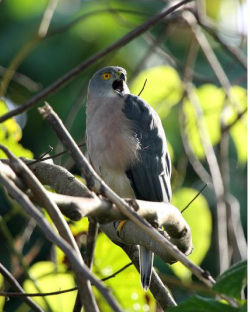
Image courtesy www.aviceda.org
The Fiji Goshawk is a medium sized hawk, ranging from 30-40cm. It is endemic to Fiji. Adult goshawks have are mostly ash-gray with a dull-pink collar and underparts, while younger birds are a deep brown in color with white underparts. The Fiji Goshawk exhibits sexual dimorphism, with females being noticably larger than their male counterparts. The Goshawk has a small range, but it can be found throughout many of Fiji's islands. However, the Goshawk is absent from the Lau Group south of Cicia. The IUCN estimates its population to range from 1,000-10,000. The Fiji Goshawk prefers a woodland habitat, but they can also frequent suburbs and city parks. The Fiji Goshawk enjoys a wide amount of prey, consuming insetcs, rodents, reptiles, and smaller birds (and occasionally larger birds, such as the Barking pigeon). Interestingly, the Goshawk has been known to occasionally take baby chickens , although this is a rare occurrence.
Fiji Woodswallow [Artamus mentalis]
Status: Least concern
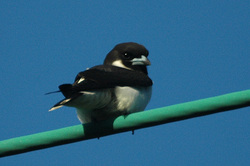
Image courtesy of Tom Tarrant
The Fiji Wood Swallow is endemic to Fiji, present on many large and small islands; however, it is notably not present on Fiji's fourth largest island, Kadavu and the Lau Archipelago. There are likely more than 10,000 Fijian Wood Swallows present throughout Fiji's different environments. Measuring approximately 18 centimers, the Fiji Wood Swallow is mostly black, with a white stomach and throat. It has a blue bill with a black tip. The Fiji Wood Swallow eats both flying and wingless insects, preying heavily on moths, butterflies, dragonflies and grasshoppers. The Fiji Woodswallow “is sedentary,” where families can occupy a tree to roost and nest for several years. The Fiji Wood Swallow can make a habitat in the Fiji dry forest region, but it is mostly found in tropical moist lowland forests and savannahs. It has also been found in highlands and urban populations.
Fiji Bush-Warbler [Cettia ruficapilla]
Status: Least Concern
Hear its song!
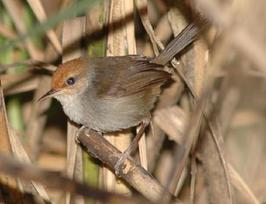
© Paul Noakes
This Fiji endemic species, along with most birds in its genus, are small insectivorous songbirds. They are terrestrial birds that live in dense vegetated areas such as thick forests or reed beds. They tend to walk away from disturbance rather than fly away. These bush-warblers have rich grayish brown backs and light grey tones on their breasts. Since most other birds in the genus Cettia share similar plumage traits and skulking lifestyle- this specific warbler may be difficult to identify and hard to see. Fiji bush-warblers have not been quantified, but the species is described as common but frequently overlooked. The population is suspected to be in decline due to habitat loss, but it is not believed to approach the thresholds for Vulnerable under the population size criterion and that is why it has been evaluated as Least Concern through the IUCN Red List.
Red Throated Lorikeet [Charmosyna amabilis]
Status: Critically Endangered
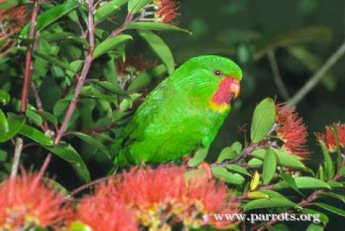
These lorikeets are entirely green except for red cheeks, throat and thighs. Their red throats are outlined with yellow and they also have yellow under-tail and tail tips. They get easily confused with the Collared Lory and they utter high-pitched squeaks while feeding or while flying. Red Throated Lorikeets can be found in small flocks high in the canopy of flowering trees, feeding on nectar and pollen in remote forest areas like Mt Tomaniivi on Viti Levu. They are endemic to the islands of Viti Levu, Vanua Levu, Taveuni and Ovalau of Fiji. This species is qualified as Critically Endangered because despite recent survey efforts, it has not been seen or heard which suggests it has a very small population. This may be the result of predation from introduced rats as well as habitat loss.
Black Throated Shrikebill [Clytorhynchus nigrogularis]
Status: Vulnerable
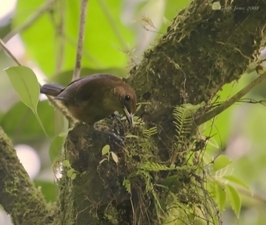
Image courtesy of http://www.barraimaging.com.au
The Black Throated Shrikebill, or Black Faced Shrikebill, is endemic to the islands of Fiji. This species experiences sexual dimorphism. The adult male has a grey-brown plumage but with a black head and throat with grayish-white ear coverts. The female is consistently brownish all over, including the head and throat. The females can be easily confused with the Wattled Honeyeater and the female Golden Whistler. Black Throated Shrikebills have a heavy, black bill with a sharp tip. Their calls have a drawn-out, wavering, whistling that has several variations. This bird is found in Viti Levu, Vanua Levu, Taveuni, Kadavu and Ovalau. It is on the IUCN Vulnerable species list due to its reported small and declining population. This is most likely due to the loss of mature old-growth forest through constant logging and forest conversion.
Peale's Barking Pigeon [Ducula latrans]
Status: Least Concern
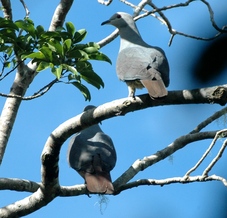
© Tom Tarrant
Peale’s Imperial Pigeon, or the Barking Imperial Pigeon, is endemic to Fiji and occurs on most of the medium and large islands. It feeds on large fruits, making it frugivorous. This species will feed in singles or as pairs and sometimes in small flocks on fruiting trees. Its breeding season is from May to January, laying only a single egg on a frail nest. Peale’s Barking Pigeon has been reported as fairly common. Because it is endemic to Fiji, it has a very restricted range and so its population trend is suggested to be in decline due to ongoing habitat destruction and unsustainable levels of exploitation. However, it is not rapid enough for its population to be assessed as Vulnerable so it has been evaluated as Least Concern on the IUCN Red List.
Pink-billed Parrotfinch [Erythrura kleinschmidti]
Status: Vulnerable
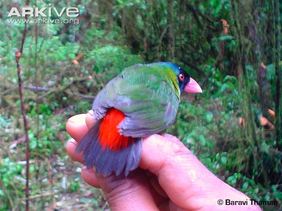
The Pink-Billed Parrot finch is endemic to Fiji, but it is only found on the island of Viti Levu. There are an estimated 2,500-10,000 birds present on the island, and as a result of this larger population, have had their conservatoin status moved from “endangered” to “vulnerable” in 2006.
The Pink-Billed Parrot finch is one of the twelve species of parrot finches found in the genus Erythrura. They are a colorful 10cm, with an green body, black face, red rump, and blue crown and nape. Like its name suggests, the Pink-Billed Parrot finch has a pink bill. It mainly lives in mature wet forest, but it can also be found in the bordering dry mature forest on Viti Levu. They feeds on insects, flower buds and fruit.
In 1913, there was an attempt to introduce them to Europe. However, this did not take. The population is still threatened by their small numbers and by habitat loss, as less than fifty percent of Viti Levu remains forested. Interestingly, the endemic Fiji Goshawk can act as a predator to the
Pink-Billed Parrot Finch.
The Pink-Billed Parrot finch is one of the twelve species of parrot finches found in the genus Erythrura. They are a colorful 10cm, with an green body, black face, red rump, and blue crown and nape. Like its name suggests, the Pink-Billed Parrot finch has a pink bill. It mainly lives in mature wet forest, but it can also be found in the bordering dry mature forest on Viti Levu. They feeds on insects, flower buds and fruit.
In 1913, there was an attempt to introduce them to Europe. However, this did not take. The population is still threatened by their small numbers and by habitat loss, as less than fifty percent of Viti Levu remains forested. Interestingly, the endemic Fiji Goshawk can act as a predator to the
Pink-Billed Parrot Finch.
Fiji Parrotfinch [Erythrura pealii]
Status: Least Concern
Hear its call!
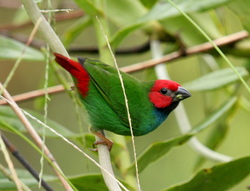
Image courtesy aviceda.org
The Fiji Parrot Finch is endemic to Fiji and is located on many islands, including Viti Levu, Vanua Levu, Taveuni and Kadavu. It is found in forested and open habitats, and can be sometimes seen in urban areas.
The Fiji Parrot Finch's diet consists of seeds, grasses, insects and nectar. When the Fiji Parrot Finch breeds, it usually lays four white eggs, producing naked and pink chicks. When it is not breeding, the Fiji Parrot Finch forms small flocks of up to six birds. The Fiji Parrot Finch is preyed upon by the endemic Fiji Goshawk, as well as the introduced mongoose and rat. However, the IUCN categorizes this bird as “least concern,” as populations appear to be stable.
The Fiji Parrot Finch's diet consists of seeds, grasses, insects and nectar. When the Fiji Parrot Finch breeds, it usually lays four white eggs, producing naked and pink chicks. When it is not breeding, the Fiji Parrot Finch forms small flocks of up to six birds. The Fiji Parrot Finch is preyed upon by the endemic Fiji Goshawk, as well as the introduced mongoose and rat. However, the IUCN categorizes this bird as “least concern,” as populations appear to be stable.
Giant Honeyeater [Gymnomyza viridis]
Status: Least Concern
Hear its call and song!
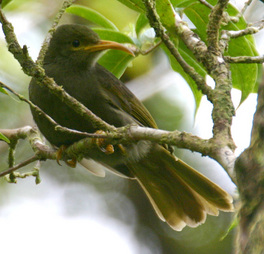
Image courtesy of http://joesbirding.blogspot.com
The giant honeyeater is endemic to Viti Levu, Vanua Levu, and Taveuni, the three largest islands of Fiji. This species' diet consists of nectar, fruit, caterpillars, insects, spiders, and lizards. Seldomly seen, the giant honeyeater is more often heard in the forest due to its distinct call. Although the population trend of the giant honeyeater is decresing, it is not decreasing at a rapid enough rate to be considered endangered. Scientists believe that this species may actually have a higher tolerance to degraded forests than originally thought, although in heavily logged forests their tolerance is quite low. Continuing loss of forest habitat remains the number one threat to this species. Conservation efforts include placing this species under protection under Fijian law and reduced logging in many of Fiji's forests.
Blue-crested Flycatcher [Myiagra azureocapilla]
Status: Least Concern
Hear its song!
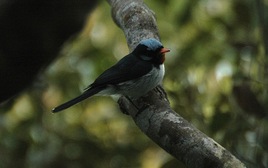
Image courtesy of Tom Tarrant
The Blue-crested Flycatcher is endemic to Fiji, where it is found on the islands of Viti Levu, Vanua Levu and Taveuni. Blue-crested flycatchers belong to a family of perching insectivore songbirds. Small in size, the Blue-crested Flycatcher is sexually dimorphic. The male has light blue crown with slate-blue upperparts, and white underparts. The female in brown above with greyish tinged cheeks and bluish tinged crown. Although the blue-crested flycatcher is experiencing a decline in population size, the rate of decrease is not enough to warrant more urgent criteria than least concern under the IUCN red list.
Orange-breasted Myzomela [Myzomela jugularis]
Status: Least Concern
Hear its call and song!
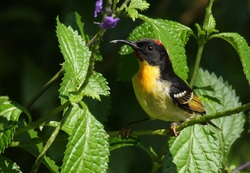
Image courtesy of ibc.lynxeds.com
The orange-breasted myzomela species is endemic to the islands of Fiji, Rotuma being the only island on which it does not breed. In addition to being a honeyeater (meaning it actually feeds on nectar), the orange-breasted myzomela is also Fiji’s smallest endemic bird species. It averages around 10 centimeters long, with black upper parts, pale yellow and white under parts, a curved bill, and black feet. The males have a scarlet red crown. When breeding, the clutch size (number of eggs laid) is typically two, with a gestation period of 14 days. Its IUCN status is "Least Concern" because its population is stable despite its small range.
Collared Lory [Phigys solitarius]
Status: Least Concern
Hear its call!
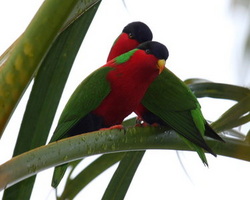
Image courtesy of Tom Tarrant
A small sized bird belonging to the group of parrots that includes lorikeets, the collared lorry can be identified by its unique and bright plumage. The head is accentuated by a dark navy blue color, which is followed by bright green, almost yellow, feathers halfway down its back. The rest of the collared lory’s body is composed of bright red plumage, the light green wings and tail being the additional exception. Endemic to Fiji, the collared lorry is common on the islands of Viti Levu, Vanua Levu, and Makogai, and rare on Ngau island. The collared lory is distinct in that it has been able to adapt and feed on non-native fruits and plants introduced into their habitat . Currently, the IUCN lists the collared lory as a bird of least concern, due to its stable population trend despite its restricted range.
Masked Shining Parrot [Prosopeia personata]
Status: Near Threatened
Hear its call!
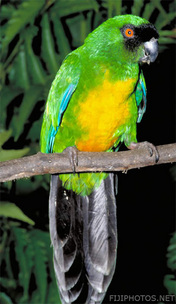
Image courtesy of ryanphotographic.com
This species can be identified by its bright green color, a long tail and an orange-yellow breast and belly. It has a dark head that becomes sooty-black towards the beak. The tail and flight feathers have a dark blue tint and it has a black bill and black feet. Its calls include a variety of raucous, penetrating squawks and screeches that they voice during flight and when perched. It feeds mostly on fruit, but also flowers, insects, seeds and berries, and nests in holes or a crack in a large forest tree, or a cavity in the top of a stump. The Masked Shining Parrot is suspected to have undergone a moderately rapid decline due to forest loss and conversion. It is endemic to the one island of Viti Levu of Fiji so it has a very specific range. However, it is not yet severely fragmented or restricted to a few locations so therefore it has been evaluated as Near Threatened.
Fiji Petrel [Pseudobulweria macgillivrayi]
Status: Critically Endangered
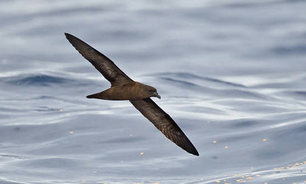
Image courtesy of www.guardian.co.uk
The Fiji Petrel can be identified by its small body, short bill, and lack of neck. This species also features a black-brown body color, and a pale silvery sheen under its wing. A pale blue patch on the center of the webbing marks its black feet. The Fiji Petrel is endemic to the island of Gau, where it is presumed to nest. Feral cat and rat predators who feed on the nesting females threaten the existence of this species. In addition, its distribution among low-lying areas means this species is susceptible to damage from climate change through sea-level rise. The IUCN currently lists the Fiji Petrel as critically endangered, and its population as declining. It is estimated that only close to 50 Fiji Petrels remain in the wild (none in captivity). The Fiji Petrel was featured on a Fijian bank note, and is significant as the only endemic Fijian seabird.
Golden Fruit Dove [Ptilinopus luteovirens]
Status: Least Concern
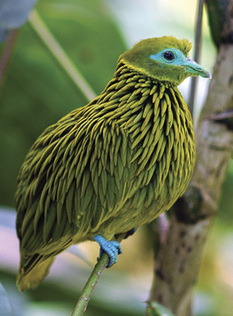
Image courtesy of Neville Coleman
A species of the dove family, the golden fruit dove is endemic to the dry tropical forests of Viti Levu. The golden fruit dove’s is a medium sized bird that is characterized by its lime green plumage, and the light blue color surrounding its eyes and marking its feet. The golden fruit dove is closely related to the orange fruit dove, as is made obvious by their similar body shape and the blue markings on their body. The golden fruit dove’s diet also includes insects. Although the population size is not accounted for, it is reported to be common and widespread in its limited range. The IUCN red list currently lists the golden fruit dove as a species of least concern.
Orange Fruit Dove [Ptilinopus victor]
Status: Least Concern
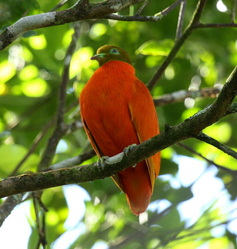
Image courtesy of www.aviceda.org
Also known as the flame dove, the orange fruit dove is a small, short tailed fruit-eating dove endemic to Fiji. The orange fruit dove is characterized by its bright orange-red plumage, olive green head, and a teal hue which accents its eyes and beak. Although this species has a small range, its population size is stable. The orange fruit dove is currently listed as least concern under the IUCN red list.
Long-legged Warbler [Trichocichla rufa]
Status: Endangered
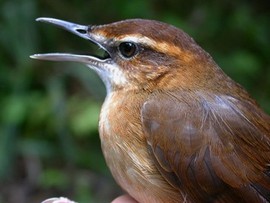
Image courtesy of AP/Getty Images
Also known as the Long-legged Thicketbird, the Long-legged Warbler is endemic to the islands of Viti Levu and Vanua Levu. Reddish brown color, white chin and throat, and a mixture of both colors on its belly can identify this species. The Long-legged Warbler also has a distinct white stripe above its eye, which fades into the back of its head. The Vanua Levu Long-legged Warbler has more pronounced white areas. A ground dwelling bird, introduced predators such as the mongoose, rats, and feral cats threaten its existence. The IUCN currently lists the Long-legged Warbler as endangered, and its population size as small, but stable and not declining. The Long-legged Warbler is special in that it is a monotopic genus, meaning it is the only species in the genus Trichocichla.
Fiji White-eye [Zosterops explorator]
Status: Least Concern
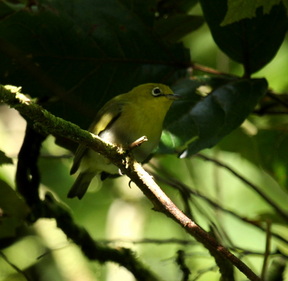
Image courtesy of Tom Tarrant
The Fiji White-eye (also known as Layard's White-eye) is a species of passerine, or perching, bird endemic to the islands of Viti Levu, Vanua Levu, Taveuni, Kadavu, and Ovalau in Fiji. The population trends and its numbers are not well known. Its back is olive green, its throat and belly are yellow, and it has a complete white eye ring. The call of the Fiji White-eye is described as "a high pitched seeu-seeu." Despite its decreasing population size and small habitat range, the Fiji white-eye is listed as a bird of least concern under the IUCN red list.
More Dry Forest Birds of Fiji
These birds are neither endemic nor endangered. Interestingly, Fiji's Dry forest also houses some seabirds and shorebirds.
For more information, please see our gallery
Back to the Top
Sources
The IUCN Red List of Endangered Species. International Union for the Conservation of Nature, 2010. Web. 01 May 2011.
BirdLife International (2011) IUCN Red List for birds. Downloaded from http://www.birdlife.org
Mercer, Robin (1967). A Field Guide to Fiji Birds. Suva: Government Press. pp. 21.
BirdForum. Web. 20 May 2011. <http://www.birdforum.net>
NatureFiji-MareqetiViti. Endangered Species of Fiji. Web. 20 May 2011. < http://www.naturefiji.org/species.php?>
The IUCN Red List of Endangered Species. International Union for the Conservation of Nature, 2010. Web. 01 May 2011.
BirdLife International (2011) IUCN Red List for birds. Downloaded from http://www.birdlife.org
Mercer, Robin (1967). A Field Guide to Fiji Birds. Suva: Government Press. pp. 21.
BirdForum. Web. 20 May 2011. <http://www.birdforum.net>
NatureFiji-MareqetiViti. Endangered Species of Fiji. Web. 20 May 2011. < http://www.naturefiji.org/species.php?>
